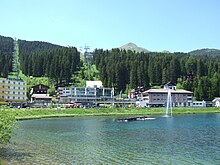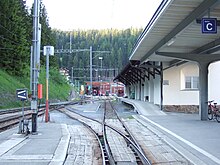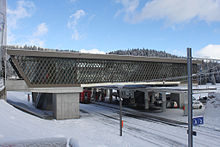Arosa train station

The Arosa train station is the station of the sports and resort Arosa in Schanfigg , canton of Grisons . It is the terminus of the Chur – Arosa (Arosabahn) railway operated by the Rhaetian Railway (RhB ) .
Location and description
The train station is in Ausserarosa and is located on the south-western side of the Obersee at 1739 m above sea level on the eastern slope of the Tschuggen , in the immediate vicinity of the Weisshornbahn and the Arosa post office . It is a terminus station . The Bahnhofplatz and the adjacent Oberseeplatz form the traffic center of Arosa and the hub for the entire bus network in Arosa. The taxi and horse-drawn carriage operators also have their main stands on Bahnhofplatz. Immediately after the train station, the Arosa Railway leads south under Seeblickstrasse into the dead straight, 299-meter-long Arosa tunnel, which crosses the Poststrasse with a steady gradient , and then leaves the Arosa village area in a northeastern direction via Seegrube and the short corner tunnel .
history
In the course of the lengthy and complex project planning of the Arosa Railway at the beginning of the 20th century, not only was the definition of the route hotly disputed for a long time, but also the location of the Arosa train station: in particular, the Arosa farm, Upper and Lower Lake , the Hubelschule and the Schwarzsee considered. A particularly noteworthy railway project with a route Chur - Parpan -Arosa envisaged the terminus in Innerarosa in addition to an Urden- Hörnli tunnel with a portal at Wasserbodasee at 2144 m .
While the last-mentioned project was definitely abandoned in 1910 in favor of a route through the Schanfigg, the Arosers soon favored a train station on the Obersee, including an intermediate station on the Untersee. There was occasional (unfounded) fear that the necessary tunnel penetration from the Untersee could endanger the water balance of the Obersee. In contrast, the construction management around chief engineer Gustav Bener advocated a location on the Schwarzsee. However, this was also out of the question as the terminus, as the local population believed that it was too far from the village center and was sometimes exposed to winter storms. A separation into a passenger station behind the English Church on Obersee and a freight station on Schwarzsee was ultimately considered too complicated.
The Arosa train station was thus left without the Untersee intermediate station on the Obersee, which Bener later commented as follows: “Whether the end section with the 290-meter-long, very expensive Aroser tunnel prescribed by interested parties to the construction management was more appropriate than the technically simpler and much cheaper one The project with the train station at Schwarzsee will only be able to prove the later development of Arosa. The current Arosa station is undisputedly one of the most beautiful railway stations in Switzerland ».
The station was designed as a terminus, but could be converted into a through station if this later turned out to be necessary or desirable. Such an adjustment was temporarily considered in 1928 when, among other things, an extension of the railway line to the Tschuggen was being discussed. In retrospect, the solution, implemented in 1914, provided a good transport base that in no way impaired the development of the health resort Arosa. The question of a fundamental change to the station system did not arise until the renovation in 2014.
Structural matters
The stately three-storey reception building is located on the lake side of the track system and has an extended, covered house platform with a free-standing station buffet with kiosk and basement toilet facilities. There is also another, open intermediate platform for operating the second track. The goods shed with loading ramp is located north of the reception building . Track number 3 leads directly to the double-track coach house , which is offset from Seeblickstrasse to the south and forms the substructure of a residential building. In addition, there are multi-track parking facilities to the north as well as connections to the refuse loading station and the central beverage depot .
The first reception building from 1914 was designed by the architects Meier and Arter in Zurich . The local Alfons Rocco took over the construction management, who in turn also designed and built the station houses between the former Chur-Sassal and Arosa stops. The architecture, which was considered successful, with clear borrowings from the Engadine architectural style , deliberately tried to reconcile the traditional charisma of a Graubünden mountain resort - including its quiet size and the harsh climate of the surrounding nature - with a certain sophisticated standard. In contrast to the wooden knitted structures of the Schanfigg intermediate stations, the building, which is worth seeing, consisted of plastered rubble stones. It was an elongated, two-story building with a gable roof , which was broken in the middle by a transverse gable , where a third floor was housed. This building provided space for railway offices, waiting rooms and station offices. The building was replaced between 1964 and 1968 by a sober new building with a flat roof and white plaster facade. This in turn received a new hipped roof and a pink paint in 1986 .
In 1917 the Arosa train station received the goods shed including a weighbridge and a stump track for peat extraction, which was extended a year later. In 1919 the railway company built a wagon shed with service apartments and a new unloading track for CHF 300,000. The civil servants' house was completed in 1920, as was the sidewalk from the reception building to Poststrasse. In 1922 the abutment in the Arosa tunnel was undercut and the station was given a new platform floor. In 1925 the paved platform was completely rebuilt and the wooden ramp at the goods shed was replaced by a concrete ramp. In 1928 the roof of the reception building was covered with sheet copper and in 1929/30 the platform roof was rebuilt in reinforced concrete and extended. In 1928 and 1930 the track system was expanded and in 1931 the second class waiting room was renovated. In 1952 the RhB removed the weighbridge from the goods shed. Since the opening of the Weisshornbahn in 1956, the establishment of a direct connection (overpass or underpass) from the platform to the valley station of the Weisshornbahn has been discussed on various occasions, but so far without result. On the occasion of the complete renovation of the reception building, the express buffet and the kiosk (popularly known as the “glass box”) were built in 1964. In 1973 the remise next to the portal of the Arosa tunnel was converted into a residential building with two remise sails on the ground floor. Only the goods shed with its arches and funnel windows remained largely unchanged in its exterior.
business
At the beginning of the 1950s, the station square often had to be cordoned off from 3:00 p.m. on winter Sundays, as the rush of people was too great as a result of the winter driving ban for cars in Arosa that was in place until 1954. As a result, passengers could only be let through to the trains in stages.
The automatic route block was introduced on November 22, 1971, and since then all the systems on the railway line have been remotely controlled from Arosa station.
The normal timetable today consists of an hourly region to Chur . Connections to the lines of the Swiss Federal Railways (SBB) in the direction of Zurich and St. Gallen as well as to the main network of the RhB are guaranteed there. Arosa train station has been the only serviced train station in Schanfigg since 1985. The annual frequency is around 300,000 passengers.
Along with Langwies station, Arosa train station would be a possible starting point for what is currently a visionary rail link between Schanfigg and the Davos landscape .
Renovation 2014
The municipality of Arosa had been hoping for a long time to be able to persuade the RhB to carry out a further, contemporary renovation of the station in time for the 100th anniversary of the Arosa Railway in 2014. In fact, Arosa train station was redesigned for over 24 million francs on this occasion. The extensive modernization was a cooperation between the RhB, the canton of Graubünden, the municipality of Arosa and Arosa Bergbahnen AG. Among other things, a direct access from the station to the Weisshornbahn via a pedestrian walkway and a redesign of the station square between the goods shed and Oberseeplatz were implemented. In addition, structural changes were made to the railway infrastructure as well as the ramps and toilet facilities in order to meet today's legal requirements for disabled people.
The corresponding planning approval process was initiated in October 2012. The public plan with the structural details was available in December 2012. The station renovation took place in different stages, while maintaining the railway operations. In a first step in summer / autumn 2013, the renovation of the reception building and the construction of a new goods handling hall were taken by hand. The redesign of the tracks and platforms as well as the station bistro including kiosk began after Easter 2014 and was completed on December 13, 2014 with the commissioning of the new overpass to the Weisshornbahn, planned by the Chur architects Ritter Schumacher.
The redesign of the station square was only implemented in summer 2016 as a result of an objection. This was accompanied by the creation of a pedestrian zone up to the goods shed instead of a meeting zone and the introduction of 30 km / h and two-way traffic on the Oberseepromenade in the area of Valsana-Oberseeparkplatz. Currently (2018) the project of a traffic-free area in front of the train station is being examined.
Varia
The listed goods shed was converted into a restaurant in 2017. For this purpose, the Blue Mountain Aktiengesellschaft, headquartered in Zug, took over the building from the RhB under construction law . A restaurant, a bar and a lounge were built in. The existing wooden gates were replaced by glass surfaces. Outside catering was also implemented. The opening of the company should have taken place on the occasion of the Arosa Humor Festival 2016. However, due to a rise in the groundwater level of 1.4 meters and an objection to the building application, the project was delayed by a year.
Due to the good connection of the train station to the valley station of the Weisshornbahn and the local bus, the municipality of Arosa was nominated in 2017 for the mobility award "FLUX - Golden Transport Hub".
See also
literature
- Ueli Haldimann , Tibert Keller, Georg Jäger : Experience the Chur-Arosa Railway - a stroll through the Schanfigg. AS Verlag & Buchkonzept AG, Zurich 2014, ISBN 978-3-906055-25-1 , p. 82 ff., 154 f.
- Hans-Bernhard Schönborn: The Rhaetian Railway . History and present. GeraMond , Munich 2009, ISBN 978-3-7654-7162-9 , pp. 115, 125.
- Beat Moser, Peter Pfeiffer: Eisenbahn Journal, Die RhB, specials part 3. St. Moritz-Samedan-Zernez-Scuol-Tarasp, Pontresina-Samedan and Chur-Arosa . The electric locomotives of the RhB. Merker, Fürstenfeldbruck 1998, ISBN 3-89610-038-6 (2nd edition 2005: ISBN 978-3-89610-150-1 ), pp. 58 f., 65, 80 f.
- Arosa municipality (ed.): Arosa in a nutshell , 4th edition, self-published by the municipality, Arosa 2005, p. 54.
- Hans Danuser : Arosa - as it was then (1962–1978) , vol. 5, self-published by Danuser, Arosa 2001, pp. 27, 55, 73, 84 f., 102.
- Hans Danuser: Arosa - as it was then (1947–1961) , Vol. 4, self-published by Danuser, Arosa 2000, p. 95.
- Hans Danuser: Arosa - as it was then (1907–1928) , vol. 2, self-published by Danuser, Arosa 1998, p. 87 ff.
- Hans Hofmann: Chur – Arosa, from the construction and operation of the railway , second edition, Calanda Verlag H. Hofmann, Chur 1989/93, ISBN 3-905260-11-5 , pp. 20, 65 f., 72, 75, 95 .
- Hans Danuser, Ruedi Homberger: Arosa und das Schanfigg , self-published by Danuser / Homberger, Arosa 1988, pp. 126–128, 131.
- Fritz Maron: From mountain farming village to world health resort Arosa , Verlag F. Schuler, Chur 1934, p. 108 ff.
Web links
- Commissioned by Jenny for the preparation of a suitability and feasibility study for a Schanfigg - Davos rail tunnel
- Arosa train station webcam with new flyover and Obersee
Individual evidence
- ↑ Hans Danuser: Arosa - as it was then (1907-1928) , Vol. 2, self-published by Danuser, Arosa 1998, p. 94.
- ↑ Jenny commissioned to work out a suitability and feasibility study for a Schanfigg - Davos rail tunnel from October 21, 2008.
- ↑ Christian Buxhofer: Merge Arosa and Davos (again). In: www.suedostschweiz.ch. October 24, 2012, accessed May 1, 2016 .
- ↑ RhB tunnel Arosa - Davos. In: www.gr.ch. November 18, 2010, accessed May 1, 2016 .
- ↑ Davos-Arosa tunnel will be updated in 2035 at the earliest. (No longer available online.) In: www.bluewin.ch. November 7, 2015, archived from the original on May 1, 2016 ; accessed on May 1, 2016 . Info: The archive link was inserted automatically and has not yet been checked. Please check the original and archive link according to the instructions and then remove this notice.
- ↑ Aroser Zeitung No. 15 of April 15, 2011, p. 3.
- ^ Die Südostschweiz, October 5, 2012, pp. 1, 3.
- ↑ Aroser Zeitung of October 5, 2012, pp. 1–3.
- ↑ Die Südostschweiz, November 13, 2014, p. 7.
- ↑ Aroser pedestrian overpass before completion. In: www.suedostschweiz.ch. November 12, 2014, accessed November 29, 2014 .
- ↑ On the 100th there is a passerelle. In: www.suedostschweiz.ch. December 15, 2014, accessed December 16, 2014 .
- ↑ Aroser Zeitung of April 29, 2016, pp. 1–3.
- ↑ Aroser Zeitung of April 27, 2018, p. 2 ff.
- ↑ Aroser Zeitung of April 1, 2016, pp. 1–3.
- ↑ From goods shed to catering business. In: www.htr.ch. March 29, 2016, accessed May 1, 2016 .
- ↑ Aroser Zeitung of June 3, 2016, p. 12.
- ↑ Arosa is nominated for a mobility award. In: www.suedostschweiz.ch. September 15, 2017. Retrieved September 18, 2017 .
Coordinates: 46 ° 47 ′ 3 " N , 9 ° 40 ′ 45.8" E ; CH1903: 771,086 / one hundred eighty-three thousand eight hundred and eighty-six





